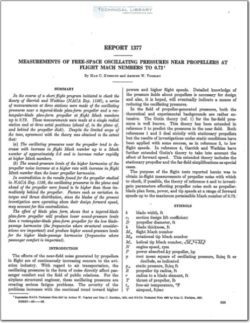NACA-Report-1377

- Version
- 158 Downloads
- 892.52 KB File Size
- 1 File Count
- December 4, 2015 Create Date
- December 4, 2015 Last Updated
National Advisory Committee for Aeronautics, Report - Measurement of Free Space Oscillating Pressure Near Propellers at Flight Mach Numbers to 0.72

The effects of the near-field noise generated by propellers
in flight are of continuously increasing concern to the avi—
ation industry. With regard to air. transportation, the
oscillating pressures in the form of noise directly affect pas—
senger comfort and the field of public relations. For the
airplane structural engineer, these oscillating pressures are
creating serious fatigue problems. The severity of the
problems increases with the continual trend toward higher
powers and higher flight speeds. Detailed knowledge of
the pressure fields about propellers is necessary for design
and also, it is hoped, will eventually indicate a means of
reducing the oscillating pressures.
In the field of propeller—generated pressures, both the
theoretical and experimental backgrounds are rather ex-
tensive. The Gutin theory (ref. 1) for the far-field pres-
sures is well known. This theory has been extended in
reference 2 to predict the pressures in the near field. Both
references 1 and 2 deal strictly with stationary propellers
but the results of investigations under static conditions have
been applied with some success, as in reference 3, to low
flight speeds. In reference 4, Garrick and Watln'ns have
further extended Gutin’s theory to take into account the
effect of forward speed. This extended theory includes the
stationary propeller and the far-field simplifications as special
cases.
The purpose of the flight tests reported herein was to
obtain in—flight measurements of propeller noise with which
to check, if possible, the theory of reference 4 and to investi-
gate parameters aflecting propeller noise such as propeller-
blade plan form, power, and tip speeds at a range of forward
speeds up to the maximum permissible Mach number of 0.72.
| File | Action |
|---|---|
| naca-report-1377.pdf | Download |

Comment On This Post